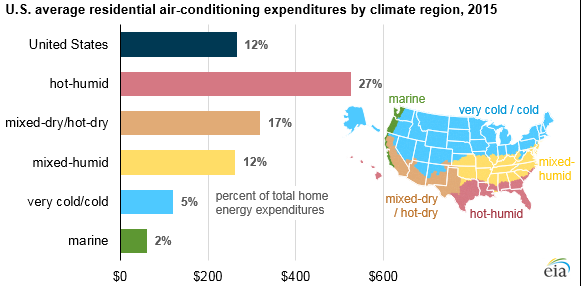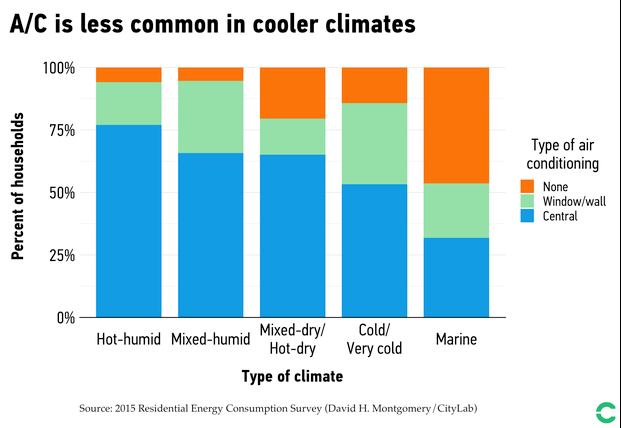With More Heat Waves, Home Air Conditioning Is Becoming a Must-Have Appliance
The dog days of summer have arrived – and so have the heat waves! Here in northern New England, we’ve already endured two long stretches of hot, muggy weather in June, with “feel-like” temperatures topping 100° F in some places.
Yet our weather woes pale in comparison to those now living under a “heat dome” that has camped out over the Pacific Northwest, where temperatures have approached 120° F in some places over recent days. With one of the lowest rates of air conditioning in the nation, some 2,000 people have been treated for heat-related illnesses. And this heat dome shows no signs of breaking down, as it may persist over the region well into July.
Hottest Year in New England
| Massachusetts | New Hampshire | Vermont | |
|---|---|---|---|
| Year | 2012 | 2012 | 2012 |
| Avg. Yearly Temperature | 61.2° F | 57.2° F | 56.2° F |
| Departure from 20th Century Avg. | 4.0° F | 3.8° F | 4.0° F |
| # Hottest Years since 2000 | 12 | 10 | 10 |
It’s not just the Pacific Northwest that’s hot. With two early-season heat waves and the warmest March-April-May period in a decade, northern New England is off to its hottest summer start since 2012 – our hottest year on record.
‘Heat Dome’ Invades Pacific Northwest
In Portland, Oregon, the mercury reached a searing 116° F on Monday, eviscerating the old record by a whopping 8° F. Now Portland has a higher all-time temperature record than more southerly cities like Dallas, New Orleans or Los Angeles. In fact, among major U.S. cities, only Phoenix and Las Vegas now have recorded hotter all-time temperatures than Portland!
Meanwhile, Seattle – which had only two days in its history with temperatures reaching 100° F – topped the century mark three days in a row earlier this week. And unlike most heat waves that arrive later in the summer, this one came right at the start of the summer season, a full month earlier than normal.
Altogether, more than 35 cities in the Pacific Northwest have tied or set records so far under this unrelenting heat dome, with many locations soaring to an unprecedented 30 to 40 degrees F above average. In Canada, excessive heat warnings have extended all the way to the Arctic Circle in the Northwest Territories.
The massive heat dome in the Pacific Northwest, depicted here on June 27, set new all-time temperature records throughout the region, with excessive heat warnings extending all the way to the Arctic Circle.
Heat Waves, Power Outages and the ‘New Normal’
This is all part of weather’s “new normal”, which we featured in another recent post. According to the National Weather Service, heat waves are now occurring three times as often as they did a half-century ago — showing up on average at least six times a year, compared to just two times a year back in the 1960s. Climate researchers estimate that record-breaking hot months are now occurring five times more often than would be expected without the influence of climate change. And these supercharged heat waves are getting larger, affecting 25% more land area in the Northern Hemisphere than they did just 40 years ago. (Including ocean areas, heat waves actually have grown 50% in size.)
The global warming connection to all of this is becoming increasingly clear. Rapid warming near the cold poles of the earth is decreasing the temperature contrast with the warm subtropics. Under the right conditions – like the ones prevailing now – the amplified warming in the Arctic is causing the jet stream to slow down and form into a very wiggly – yet stubbornly stable – weather configuration. Recent research suggests that once this “wave resonance” pattern sets in place, it may persist over a region for weeks on end. Moreover, the frequency of such persistent heat waves may increase over time by 50 percent, as global temperatures continue their inexorable rise.
One consequence of longer and more intense heat waves is more frequent and widespread utility power outages. From 2015 to 2020, for example, the number of annual blackouts in the United States has doubled. On average, such power outages cause $70 billion in economic losses annually (although the tally for the recent winter blackout in Texas is closer to $200 billion!).
With more blackouts coming during hot summer months, it’s clear that rising temperatures and more air conditioning use are stressing the grid as never before. According to one recent analysis of three large U.S. cities, a future combined blackout and heat wave could expose at least two-thirds of their residents to heat exhaustion or heat stroke.
Air Conditioning Is a Life Saver
Heat waves lasting for three-day periods or longer are our nation’s most dangerous type of severe-weather event. By one estimate, such heat-induced illnesses kill about 12,000 Americans each year. Over the least 30 years, heat waves actually have caused more annual deaths on average than hurricanes and floods combined!
In the Pacific Northwest, recent research projects that heat stress will triple by 2100 unless aggressive action is taken to reduce heat-trapping emissions. New England is on a similar path, as hot-humid climate conditions creep toward our region.
To cope with such life-threatening weather events, central air conditioning is now becoming a standard feature in most new homes across America. As recently as 30 years ago, only about two-thirds of all occupied housing units had some form of air conditioning. In the last 10 years, that figure has risen to nearly 90%. In fact, it’s now more common for a U.S. household to feature air conditioning of some kind than to have a dining room or a garage.
Unfortunately, all that air conditioning is adding up to more power demand and higher greenhouse gas emissions. All told, air conditioners now use about 6% of all the electricity produced in the United States and are responsible for nearly 120 million metric tons of carbon dioxide emissions released into the atmosphere each year. Breaking it down, each central air conditioning unit emits about two tons of carbon dioxide as a yearly average.
To avoid a positive feedback loop, whereby higher air conditioning loads lead to higher greenhouse gas emissions, there are some easy ways to cut down on overall air conditioning use. For example, setting a programmable thermostat to cycle air conditioner use throughout the day cuts their power demand nearly in half compared to running them all the time, without compromising comfort or safety. Turning the thermostat up also eliminates about 120 pounds of CO2 emissions for each degree above a minimum 72° F temperature setting.

From a budgeting standpoint, we still spend about four times as much heating our homes than cooling them. However, this gap is shrinking. In the hot-humid region that’s spreading our way, air conditioning is used by nearly 95% of all households and represents more than one-quarter of total home energy expenditures. By comparison, here in northern New England, where a majority of the housing stock still lacks central air conditioning, only about 5% of total home energy expenditures are devoted to air conditioning.
Record Cooling Demand
| Massachusetts | New Hampshire | Vermont | |
|---|---|---|---|
| Year | 2018 | 2018 | 2005 |
| Cooling Value | 693° F | 439° F | 367° F |
| Departure from 20th | 338° F (+48%) | 225° F (+51%) | 199° F (+54%) |
| Years with Most Cooling Demand since 2000 | 12 | 12 | 10 |
This percentage is sure to increase as more hot weather comes our way. In Massachusetts and New Hampshire, for example, the value of “cooling degree days” (where ambient temperatures exceed a mean daily value of 65° F) set an all-time record just three years ago, in 2018. (Vermont’s cooling-degree record was set back in 2005.) In all three states, the record departure in cooling degree days is about 50% above the 20th century average and, since 2000, new “top 10” cooling-load records are being set at a rate of every other year.

Taking Action to Stay Cool
Air conditioning systems are not the only way homeowners can beat the heat, however. Some households use ceiling fans, dehumidifiers and evaporative coolers to stay cool and comfortable in hot and muggy weather.
Another increasingly popular option is to install electric heat pumps that can cool homes efficiently on hot summer days, while keeping them toasty warm on cold winter days. Heat pumps (which, like other home electrical appliances can run on solar power) come in both room and whole-house configurations. More information on heat pumps is available here.
By outfitting your home with solar power, a smart inverter and a back-up battery system, it’s possible to keep your lights on – and the AC running – for hours, or even days, on end without accessing the grid. And for every kilowatt you generate with solar, no carbon emissions come from running your air conditioner or other home appliances – breaking the positive feedback loop that comes from running AC on carbon energy sources.
So, with so much hot weather in the forecast — now and in the years ahead – what are you waiting for? By going solar and installing highly efficient heat pumps, you’ll be fighting global warming now – and stay cool doing it!
Solaflect Energy is your home energy management partner. We help you install clean and affordable solar electricity and home battery systems for a more resilient and climate-friendly future. Click here to contact us, or email info@solaflect.com, or call (802) 649-3700, or text (802) 308-3018. Working together, the power is in our hands to make a difference!





